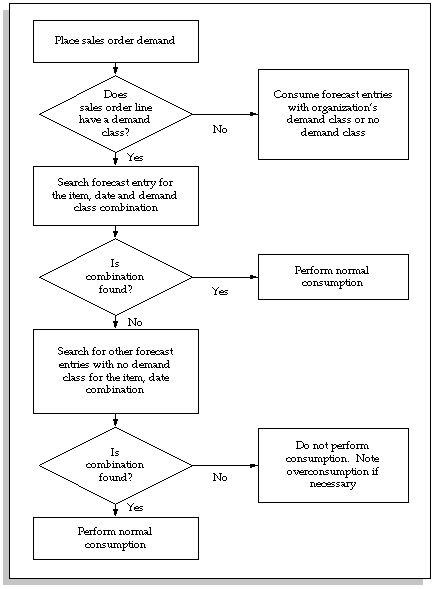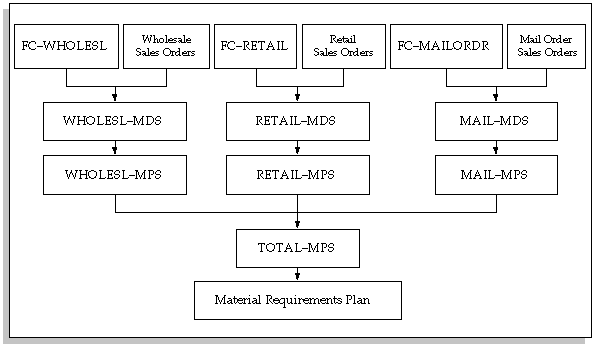Demand Classes
Overview of Demand Classes
Demand classes allow you to segregate scheduled demand and production into groups, allowing you to track and consume those groups independently. A demand class may represent a particular grouping of customers, such as governmental and commercial customers, or it may represent sales channels or regions. Demand classes may also represent different sources of demand, such as retail, mail order, and wholesale.
Defining Demand Classes
You can optionally define demand classes to group similar customers or sales orders. You can use demand classes as a means of forecasting different sources of demand separately.
Associate Demand Classes to Customer Demand
You can associate a demand class to a customer ship to address in Oracle Receivables and to an order type in Oracle Order Management. Oracle Order Management automatically assigns a demand class to a sales order line using either the demand class associated to the customer ship to address or the order type.
Assign an Organizational Demand Class
You can assign a default demand class to your organization. Oracle MRP uses this demand class during forecast consumption, and shipment and production relief.
Forecasting by Demand Class
You can optionally associate a demand class to a forecast when you define the forecast name. When you place sales order demand, the forecast consumption process consumes the forecast with the same demand class. If the forecast consumption process does not find a forecast, it consumes entries that have no demand class. If you place sales order demand that does not have an associated demand class, the forecast consumption process attempts to consume forecast entries associated with the organizational default demand class first, and then consume entries that have no demand class defined.
Master Scheduling by Demand Class
You can optionally associate a demand class to a master demand schedule or master production schedule when you define the master schedule name. When you ship a sales order or create a discrete job, that sales order or discrete job consumes the master schedules that are associated with the demand class of the sales order or discrete job. After consuming master schedules with the same demand class as the sales order or discrete job, Oracle MRP consumes master schedules with no demand class.
You can load a subset of the sales orders into your master schedule for a specific demand class.
Planning by Demand Class
You can limit the netting of discrete jobs, repetitive schedules, flow schedules, reservations, and subinventories when planning a master production schedule. If you are planning a master production schedule that has an associated demand class, it only nets discrete jobs and repetitive schedules that have the same demand class. You can segregate your subinventories and reserved inventory by demand class and selectively net them when launching the planning process.
Demand Class Forecasting
You can use demand classes as a means of forecasting different sources of demand separately. For example, suppose your company has three primary sources for sales orders: wholesale sales, retail sales, and mail order sales. Each source has a different sales force you forecast independently. You may wish to create a separate forecast name for each source and maintain each forecast independently. However, Oracle MRP considers all sources of forecasted and sales order demand together.

In the above diagram, your master scheduler has created three forecast names: FC–WHOLESL, FC–RETAIL, and FC–MAILORDER. You maintain and report on each forecast independently. Note that these forecasts are defined within a forecast set.
Your master scheduler combines all sources of demand, including the three forecasts and all sales orders, into a single statement of demand—the master demand schedule. The master scheduler then plans the master production schedule and the MRP plan with all the demand combined.
See Also: Overview of Forecasting
Forecast Consumption
You can associate a demand class with each sales order. When you place sales order demand, the forecast consumption process consumes the forecast with the same demand class. If the forecast consumption process does not find a forecast, it consumes entries that have no demand class. If a sales order does not have an associated demand class, the forecast consumption process attempts to consume forecast entries associated with the organizational default demand class first, and then consume entries that have no demand class defined.
Abnormal Demand
Certain sales orders should not consume the forecast, because they are not indicative of what orders you expect in the future. For example, suppose you manufacture soft drinks, and have 100 primary distributors to whom you sell. Your sales order demand is roughly even across those distributors. One of those distributors has a special promotion on your product, and places orders for ten times their normal amount. The large order by this one distributor does not mean that your other distributors will order less. Therefore, you might mark this particular order as abnormal.
To prevent a sales order from consuming forecasts, associate the sales order to a demand class that does not have a corresponding forecast and is not the same as the demand class for your organization. In this case, the forecast consumption process does not consume any forecast for the sales order.
Tip: You should define a demand class for abnormal demand and assign it to an order type that you can associate with sales orders you might mark as abnormal.
The following diagram depicts the forecast consumption process:

Demand Class Master Scheduling
You may wish to make further use of demand classes by segmenting not only your forecasted demand, but also your scheduled production by demand class:

In the above diagram, suppose your master scheduler has created three forecast names: FC–WHOLESL, FC–RETAIL, and FC–MAILORDER. You maintain and consume each forecast independently. However, rather than combining all forecast and sales order demand into a single master demand schedule, as was done in the previous diagram, your master scheduler maintains three demand schedules: WHLSAL–MDS, RETAIL–MDS, and MAIL–MDS. Each demand schedule consists of the forecast and actual demand associated to a specific demand class.
Your master scheduler also maintains three separate master production schedules: WHLSAL–MPS, RETAIL–MPS, and MAIL–MPS. You plan each master production schedule independently. In this manner, not only has the master scheduler broken out the sources of demand into separate groupings, but has also segregated units of production by demand class as well.
To drive the MRP plan, the master scheduler combines all sources of production into a single master production schedule, thus driving the MRP plan by the aggregate master production schedule. The master scheduler manually combines master schedules into a single master schedule, using the Load/Copy/Merge Master Demand Schedule or Load Master Production Schedule windows. See: Loading a Master Schedule From an Internal Source
Maintaining the Master Production Schedule
You can allocate your discrete production by sales channel using demand classes. You can manually or automatically define discrete jobs to build configurations for your assemble–to–order or make–to–order products. You can also associate discrete jobs with sales orders for standard products to ensure customer satisfaction.
When you create a discrete job, it must consume the master production schedule for the demand class that satisfies the discrete job. Therefore, a discrete job can have an associated demand class. Oracle Work in Process automatically specifies the demand class when you manually define a job or create a configuration order for a specific sales order.
See Also
Discrete vs. Repetitive Manufacturing, Oracle Work in Process User's Guide
Demand Class ATP Calculation
You can specify that Available to Promise (ATP) be calculated by demand class. In this case, the available to promise calculation only considers master production schedule entries associated with the appropriate demand class as available to promise. You can also segregate and calculate sales order demand by demand class as well.
See Also
Overview of Configure to Order, Oracle Bills of Material User's Guide
Net Inventory by Demand Class
You can net your inventory by demand class so that you do not have the same items satisfying multiple demand classes. You can net your inventory by demand class in one of two ways:
-
You can net items by subinventory. For example, items that are available to satisfy Wholesale demand class are in a separate subinventory than those items that satisfy the Retail demand class. You specify the Wholesale subinventory as nettable and the Retail subinventory is non–nettable when planning the Wholesale demand class, and vice versa when planning the Retail demand class. This relies upon you manually overriding the subinventory netting when launching the planning process.
-
You can reserve all items in a subinventory for a sales order. You can determine the items in the subinventory reserved for the demand class by the sales order associated with the demand class. Note that this method requires the full use of hard reservations.
See Also
Viewing Item Reservations, Oracle Inventory User's Guide